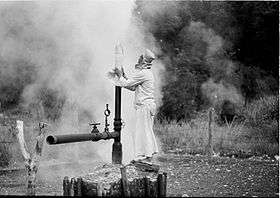Kamojang
| Kamojang | |
|---|---|
 Work at Kawah Kamojang in 1935 | |
| Highest point | |
| Elevation | 1,730 m (5,680 ft) [1] |
| Coordinates | 7°07′30″S 107°48′00″E / 7.12500°S 107.80000°ECoordinates: 7°07′30″S 107°48′00″E / 7.12500°S 107.80000°E |
| Geography | |
| Geology | |
| Mountain type | stratovolcano |
| Last eruption | Pleistocene |
Kamojang, popularly known as Kawah Kamojang or (the Kamojang crater), is a geothermal field and tourist spot in West Java, Indonesia. The crater is located in sub-district (kecamatan) Ibun in the Bandung Regency, approximately 45 km to the southeast of Bandung through the towns of Majalaya and Ibun. The crater can also be reached from the opposite direction through the town of Garut, in Garut Regency (the distance by road from Garut to the northwest through the township of Samarang is around 25 km).
The volcano that the crater is located on is Mount Guntur but the crater itself is listed as an active volcano of Indonesia because of its geothermal activities.[1]
Geothermal activities
There is a long history of interest in the possibility of developing the geothermal potential of the Komojang region. The first geothermal wells in Indonesia were drilled at Kamojang in 1926 by the Dutch colonial government. The current geothermal field is on the slopes of Mt Guntur, about 7 km to the west of the peak of the mountain. There are four operating geothermal generating units with a capacity of 200 MW. The fourth unit began operation in January 2013. A fifth unit with a planned capacity of 35 MW was contracted in October 2013 with estimated construction completion by July 2015.[2]
Komojang is the site of the first modern geothermal site in Indonesia, commissioned by former president Soeharto in January 1983. The four current units, with a capacity of 200 MW, are owned and operated by PT Indonesia Power, a subsidiary of the Indonesian state-owned electricity generating corporation, Perusahaan Listrik Negara (PLN). The concession to the field is held by PT Pertamina Geothermal Energy, a subsidiary of another of Indonesia's major state-owned companies, PT Pertamina.[3]
See also
References
- 1 2 "Kawah Kamojang". Global Volcanism Program. Smithsonian Institution. Retrieved 2006-12-21.
- ↑ ', "Bloomberg New Energy Finance", 7 October 2013.
- ↑ 'Pertamina, PLN to jointly develop power plants', The Jakarta Post, 11 August 2000.
